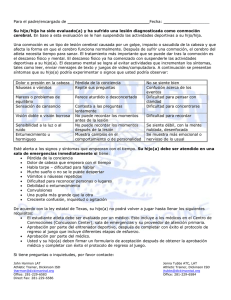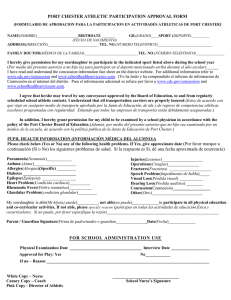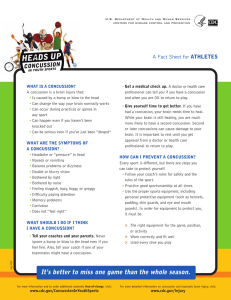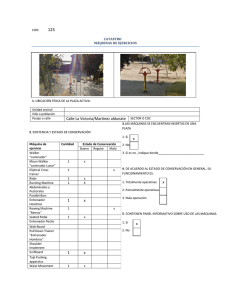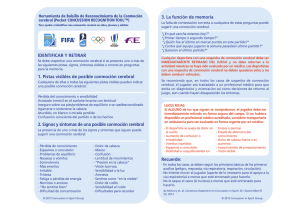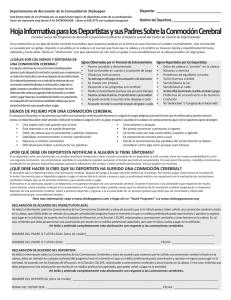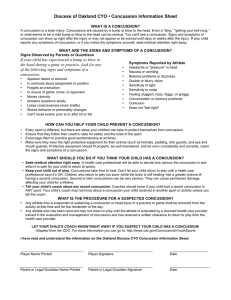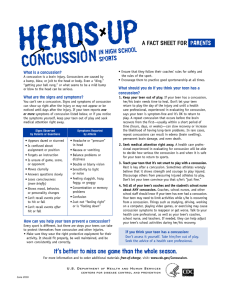concussion information for athlete and parent
Anuncio
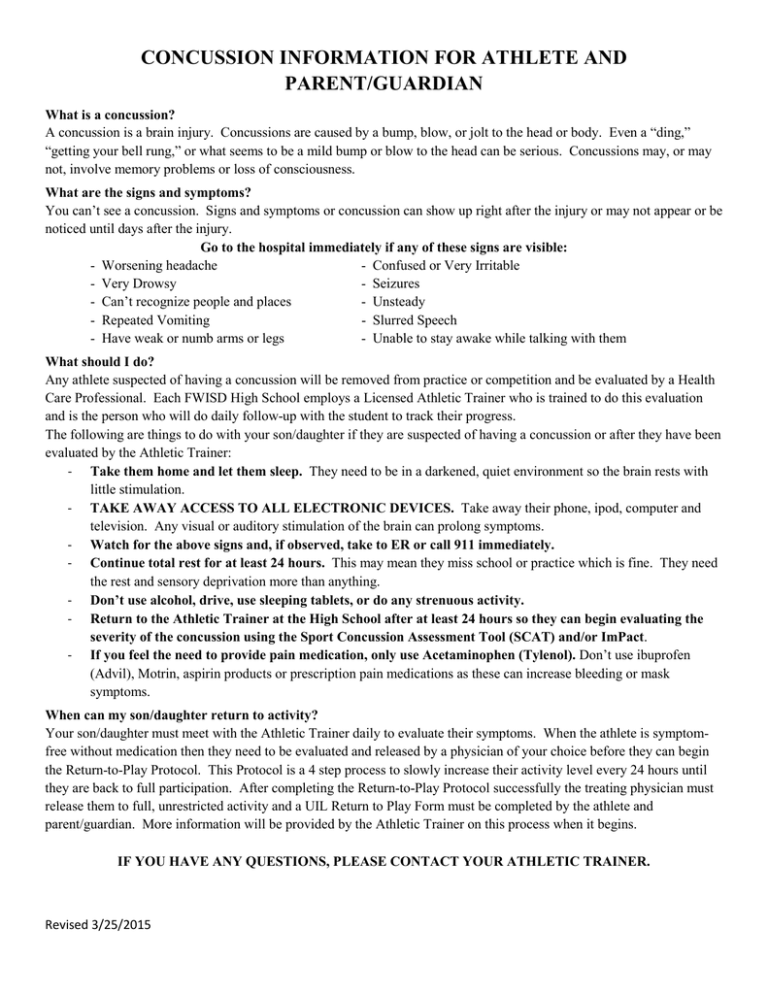
CONCUSSION INFORMATION FOR ATHLETE AND PARENT/GUARDIAN What is a concussion? A concussion is a brain injury. Concussions are caused by a bump, blow, or jolt to the head or body. Even a “ding,” “getting your bell rung,” or what seems to be a mild bump or blow to the head can be serious. Concussions may, or may not, involve memory problems or loss of consciousness. What are the signs and symptoms? You can’t see a concussion. Signs and symptoms or concussion can show up right after the injury or may not appear or be noticed until days after the injury. Go to the hospital immediately if any of these signs are visible: - Worsening headache - Confused or Very Irritable - Very Drowsy - Seizures - Can’t recognize people and places - Unsteady - Repeated Vomiting - Slurred Speech - Have weak or numb arms or legs - Unable to stay awake while talking with them What should I do? Any athlete suspected of having a concussion will be removed from practice or competition and be evaluated by a Health Care Professional. Each FWISD High School employs a Licensed Athletic Trainer who is trained to do this evaluation and is the person who will do daily follow-up with the student to track their progress. The following are things to do with your son/daughter if they are suspected of having a concussion or after they have been evaluated by the Athletic Trainer: - Take them home and let them sleep. They need to be in a darkened, quiet environment so the brain rests with little stimulation. - TAKE AWAY ACCESS TO ALL ELECTRONIC DEVICES. Take away their phone, ipod, computer and television. Any visual or auditory stimulation of the brain can prolong symptoms. - Watch for the above signs and, if observed, take to ER or call 911 immediately. - Continue total rest for at least 24 hours. This may mean they miss school or practice which is fine. They need the rest and sensory deprivation more than anything. - Don’t use alcohol, drive, use sleeping tablets, or do any strenuous activity. - Return to the Athletic Trainer at the High School after at least 24 hours so they can begin evaluating the severity of the concussion using the Sport Concussion Assessment Tool (SCAT) and/or ImPact. - If you feel the need to provide pain medication, only use Acetaminophen (Tylenol). Don’t use ibuprofen (Advil), Motrin, aspirin products or prescription pain medications as these can increase bleeding or mask symptoms. When can my son/daughter return to activity? Your son/daughter must meet with the Athletic Trainer daily to evaluate their symptoms. When the athlete is symptomfree without medication then they need to be evaluated and released by a physician of your choice before they can begin the Return-to-Play Protocol. This Protocol is a 4 step process to slowly increase their activity level every 24 hours until they are back to full participation. After completing the Return-to-Play Protocol successfully the treating physician must release them to full, unrestricted activity and a UIL Return to Play Form must be completed by the athlete and parent/guardian. More information will be provided by the Athletic Trainer on this process when it begins. IF YOU HAVE ANY QUESTIONS, PLEASE CONTACT YOUR ATHLETIC TRAINER. Revised 3/25/2015 INFORMACIÓN ACERCA DE CONMOCIONES CEREBRALES PARA ATLETAS Y PADRES/GUARDIANES ¿Qué es una conmoción cerebral? Una conmoción cerebral es una lesión del cerebro. Son causadas por un golpe o sacudida a la cabeza o el cuerpo. Cualquier golpe que cause un “timbre” o lo que parezca ser un pequeño sacudido a la cabeza puede ser muy serio. Conmociones cerebrales pueden o no involucrar problemas con el conocimiento o pérdida de la conciencia. ¿Cuáles son los síntomas? No se puede ver una conmoción cerebral. Síntomas de una conmoción cerebral pueden surgir inmediatamente después de una lesión o quizá no aparecerán o serán observados hasta días después del incidente. Vaya al hospital INMEDIATAMENTE si algunos de estos síntomas son visibles: -Un dolor de cabeza que decaiga -Confusión o mucha irritabilidad -Un sueño o modorra profusa -Un ataque o derrame -No puede reconocer a la gente y lugares -Inestable o tambaleante -Vomito repetido -Habla incompresible -La inhabilidad de mantenerse despierto mientras intenta hablar con usted -Brazos o piernas débiles o “dormidas” ¿Qué debo hacer? Un atleta sospechado de haber sufrido una conmoción cerebral será apartado de la práctica o competencia y será evaluado por un profesional médico. Cada una de las preparatorias del Distrito Escolar de Fort Worth emplea a un entrenador de atletas autorizado para hacer este tipo de evaluación y es la persona designada de llevar acabo evaluaciones diarias para observar el progreso del estudiante. Las siguientes cosas se pueden hacer con su hijo/ hija si es que se sospecha de haber sufrido una conmoción cerebral o después de haber sido evaluado por el entrenador: -Llévelo a casa y deje que duerman. Deben de estar en un ambiente tranquilo y oscuro para que el cerebro descanse con poca estimulación. -¡NO PERMITA EL USO DE APARATOS ELECTRÓNICOS! Elimine uso del teléfono, el IPOD, computadora y la televisión. Cualquier estimulación visual o auditiva prolongara los síntomas. -Observe los síntomas mencionados anteriormente; si los nota, llévelos a la sala de emergencia INMEDIATAMENTE. -Continúe el descanso por lo menos 24 horas. Esto significa que quizá puedan faltar a la escuela o a la práctica, que en este caso será aceptable. Necesitan el descanso y limitar actividad sensorial más que nada. -No usen alcohol, conduzca vehículos, no use píldoras para dormir, o ninguna otra actividad estrenua. -Regrese al entrenador de atleta en su escuela después de 24 horas para que así pueden empezar la evaluación de la severidad de la conmoción cerebral. Esto se hará con el uso de equipo SCAT y/o ImPact. -Si usted siente la necesidad de administrar medicamentos, solamente use Acetaminophen (TYLENOL). NO USE ibuprofen (ADVIL), Motrin, o productos que contienen aspirina o medicamentos recetados, ya que éstos pueden aumentar el desangre o enmascarar los síntomas. ¿Cuándo podrá mi hijo/ hija regresar a la actividad? Su hijo/hija debe de consultar con el entrenador de atletas a diario para evaluar los síntomas. Cuando el atleta ya no tenga ninguno de los síntomas tendrá que ser evaluado y dar de alta por un médico. Así el atleta podrá empezar la progresión para volver a jugar. Esta progresión consiste de 4 pasos que lentamente incrementa la actividad cada 24 horas hasta que lleguen a un nivel en el cual podrán participar completamente. Ya que completen este proceso tendrán que llenar la forma “Return to Play” por parte del guardián y por el atleta. Más información será proporcionada por el entrenador de atletas al empezar esta parte del proceso. SI TIENE CUALQUIER PREGUNTA, POR FAVOR COMUNIQUESE CON EL ENTRENADOR DE ATLETAS ASIGNADO A SU ESCUELA. Fuente de información se puede encontrar en www.impacttest.com; SCAT; El departamento de Salud y Servicios de los E.E.U.U. y el centro de enfermedades y prevención Revisado 10/15/2013 Traducción por Paola Rodríguez- DHJ High School
